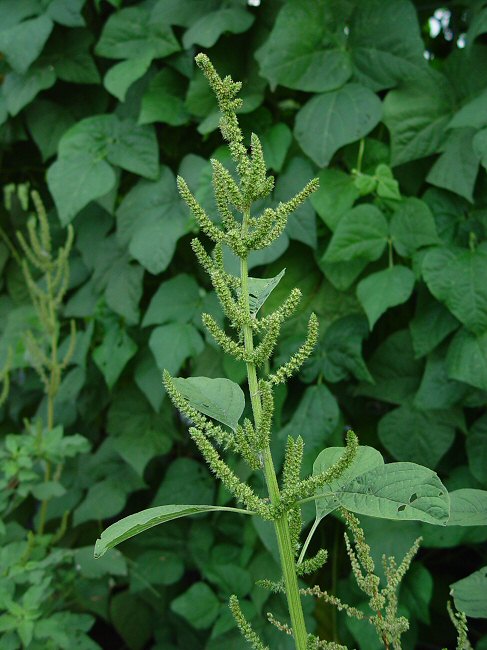Amaranthus hybridus L.
Green Amaranth

Native
CC = 0
CW = 5
MOC = 50
© DETenaglia
Amaranthus hybridus L.Green Amaranth | |
 |
Native CC = 0 CW = 5 MOC = 50 |
© DETenaglia |
|
Family - Amaranthaceae Habit - Annual monoecious forb. Stems - Ascending to erect, to 2 m, pubescent, unarmed.
Leaves - Alternate, petiolate. Blades 2-15 cm long, lanceolate to ovate or elliptic, bluntly or sharply pointed, often minutely notched at the tip, narrowed or tapered at the base, the surfaces sparsely to moderately pubescent, mostly along the veins with inconspicuous, crinkled, multicellular hairs, the upper surface sometimes glabrous or nearly so.
Inflorescence - Dull or grayish green, occasionally reddish-tinged, axillary and terminal, the axillary inflorescences short spikes or less commonly dense globose clusters, the terminal inflorescence usually a panicle with numerous clusters of short, dense spikes branching along most of the axis, the flowers mostly continuous along the spikes, the tip often curved or nodding, the main axis and branches moderately to densely pubescent with mostly crinkled, multicellular hairs. Bracts 2-4 mm long, the main body similar in size to the fruits, but the entire structure (including the awnlike extension of the midrib) conspicuously longer than the fruits, lanceolate to ovate, narrowed or tapered to a sharply pointed tip, with a strongly thickened green midrib and narrow or broad, thin, papery margins, the midrib usually extending beyond the main body as a short awn, spinelike at maturity.
Flowers - Staminate flowers with 5 sepals, these 1.5-2.3 mm long, straight, elliptic to oblong-ovate, sharply pointed, usually tapered to a short, awnlike extension of the midrib. Pistillate flowers with 5 sepals, these 1.5-2.3 mm long, otherwise similar to sepals of staminate flowers. Petals absent. Stamens 5. Stigmas 3, erect or less commonly somewhat spreading. Ovule 1.
Fruits - Fruits 1.2-2.0 mm long, with circumscissile dehiscence, the surface finely wrinkled above the midpoint when dry. Seeds 0.8-1.2 mm in diameter, rounded along the rim, the surface reddish brown to more commonly black, shiny. Flowering - July - October. Habitat - Waste ground, cultivated fields, disturbed sites, roadsides, railroads. Origin - Native to the U.S.? Lookalikes - Other species of Amaranthus and Chenopodium. Other info. - This weedy species can be found throughout Missouri and is quite common in the habitats mentioned above. The plant can get quite robust and attain a height of around 1 m. Photographs taken off Main St., Ellington, MO., 7-18-04. |